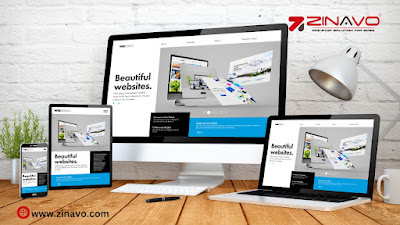How to Optimize Your Web Design for Better Conversions?
Introduction:
A successful website can create customers, not just act as a digital advertisement. It is critical to note that even with a large amount of traffic if your site is not optimised for conversions income is left on the table. Whether you're an ecommerce brand service provider or software company, smart web design improves conversion rates. Our goal in this blog is to educate you on how to optimize your web design in order to improve conversions.
1. Understand Your Target Audience
The process of conversion begins with a thorough understanding of your users. Why do they suffer from these problems? How do they use their devices? What motivates their buying decision?
When you have a data-driven understanding of your audience, you can design user flows that guide visitors to take action. Use tools such as Google Analytics, Firebase, or surveys to gather information about visitor behavior. A site customized to a user's needs will always perform better than a generic one.
2. Simplify Your Navigation
One of the biggest barriers to conversion is a complex or confusing navigation system. It is recommended that visitors are able to find what they are looking for within two to three clicks.
You should keep your menu simple by using simple labels such as Home, Services, Pricing and Contact. Every page of your website should include a clear call-to-action (CTA) and sticky headers. Your offer will be more focused on the user if the navigation is clear and easy to understand.
3. Optimize Your Call-to-Actions (CTAs).
If you are looking for conversion points for your website, CTAs are the most effective, whether they are Buy Now, Schedule A Demo, or Contact Us buttons.
Make sure of CTAs:
Stand out with a contrasting color
Use action-oriented language (e.g., Start the Free Trial)
Are strategically placed (above the fold, at the end of page, and at key scrolling points)
Also, don’t confuse users with too many CTAs. Guide them clearly and purposefully.
4. Improve Page Loading Speed
The speed of a website has a direct impact on conversion rates. It has been shown that a 1 second delay in loading the page can decrease conversions by up to 7%.
To boost speed:
Compress images and videos
Use caching and a content delivery network (CDN).
Reduce the number of JavaScript and CSS files
Choose a fast, reliable web host
A fast website keeps users engaged and improves the user experience leading to more conversions.
5. Make it mobile-responsive.
Mobile devices are now used by more than 60% of users to browse websites. Conversions are lost without mobile optimization.
Key mobile optimization tips:
Use a responsive design framework (such as Bootstrap or Tailwind).
Ensure buttons and links are touch-friendly
Avoid heavy media files
Make text easily readable without zooming
A mobile-friendly version of a site improves conversion rates and is featured higher in Google's mobile-first search results.
6. Use Visual Structure and White Space
Design your website so that users can quickly locate the most important content and call to actions. This is where visual structure and white space are important.
Use:
Larger fonts and bolder colors for headlines
Contrasting buttons for key actions
Lots of white space to reduce cognitive load
This not only improves aesthetics but also makes the website easier to scan, which increases engagement and conversions.
7. Add Social Proof and Trust Signals
Visitors often hesitate to act without assurance. Include trust-building elements like:
Customer reviews
Case studies
Reviews and ratings
Certifications or security badges
These reassure users that they’re making a safe decision. Display these prominently, especially near your CTAs.
8. A/B Testing and Optimizing Continuously
An effective conversion-focused web design cannot be completed in one go. You need to test different versions of your pages, headlines, images and CTAs to see what works best.
Use tools like Google Optimize, VWO or Optimizely to run A/B tests and measure what leads to higher engagement and conversions. When small changes are made over time, they can have a significant impact.
9. Include a clear value proposition
How can someone benefit from buying from you or contacting you? You should be able to clearly communicate your value proposition within the first five seconds of landing on your website.
The headline should be placed above the fold, the benefits should be explained and how you differ from your competitors should be highlighted. Users are more likely to take action when they read benefits-focused copy coupled with visuals.
10. Integrate Live Chat and Support
Live chat, chatbots or direct contact improve customer trust and satisfaction. Getting users' doubts clarified instantly increases the chances of conversion. Make your chat icon visible without being annoying.
Conclusion
Web design is not just about looking good. It's about functionality, user experience and design that drives conversions. A website that does more than just attracts visitors but converts them into loyal customers should simplify navigation and optimize CTAs, improve speed and understand its target audience. Zinavo develops high-converting websites that are well-designed, SEO-friendly and customized to your business' needs. We combine user experience, marketing insight and technology to ensure your website does more than just looks good it achieves results. Make your website a powerful conversion engine by contacting Zinavo today for a free consultation.
For more information:
Call Us: +91 80-35694395
WhatsApp Us: +91-7760245945
Email: info@zinavo.com
Visit: https://www.zinavo.com


Comments
Post a Comment